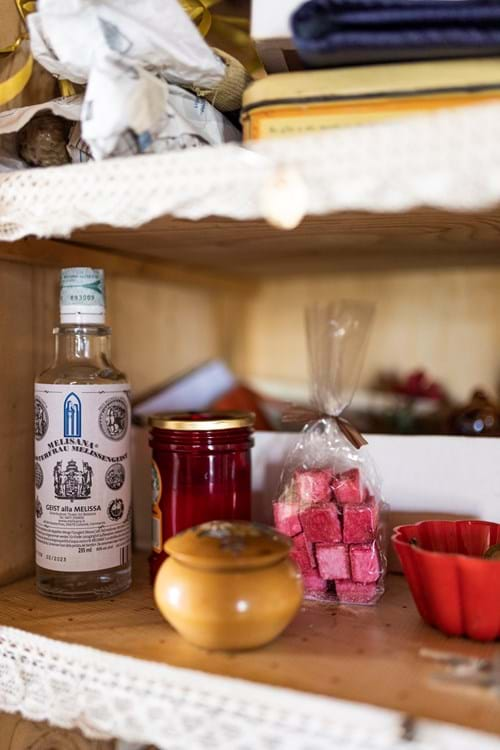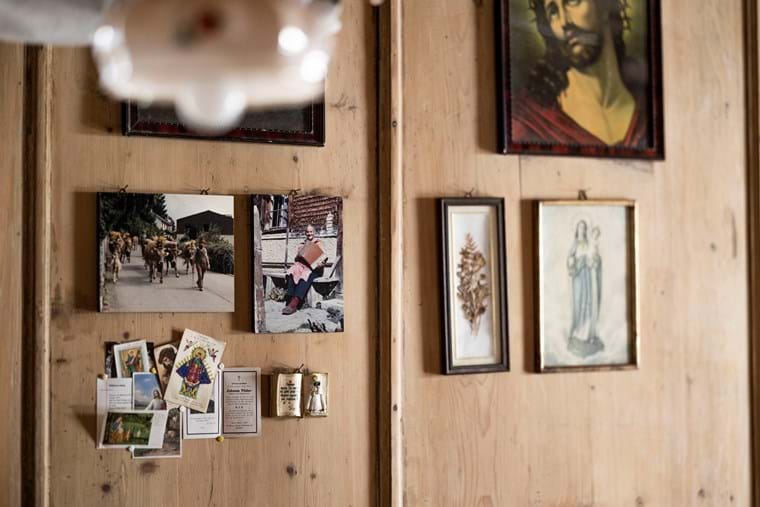Anna must say goodbye. The lines between reality and memory are blurring in “Der Maulbeerbaum” (“The Mulberry Tree”), a short film by Cornelia Schöpf and Federico Campana. A visit to the film set in Andrian/Andriano.
“Who’s taking the flowers?” Silence ensues. “You take them, I don’t want them.” In the dim light, Rosi slowly reaches for the flower pot on the windowsill in the old farmhouse parlour. Her sister Hilda is standing next to her, unmoving. But around the two women, there is a lot of movement. The two directors, Cornelia Schöpf and Federico Campana, are sitting on a bench by the stove in the corner. They confer briefly, looking very much at ease with each other. Then Schöpf jumps to her feet, weaves her way through the film crew, and gives the two actresses some more directions: the directors are not quite happy with the scene yet. Agnes Öttl and Agnes Maierhofer, who play Rosi and Hilda, repeat the scene three more times. Then it’s a wrap. “OK, grazie”, says producer Matthias Keitsch (Albolina Film) to the team. Multilingual communication is a given at the set of Der Maulbeerbaum. Everyone understands English, German, and Italian—because everyone bears some relation to South Tyrol/Südtirol. Those who are not from here have studied at the ZeLIG film school in Bolzano/Bozen. That is where Schöpf, who hails from Lana, and Campana, a native of the Emilia-Romagna region, first met. After working together on several documentaries, they are now directing their first feature film together.
In the 15-minute production Der Maulbeerbaum by Albolina Film, Anna (played by Marlies Untersteiner) returns to her grandmother’s farm together with her mother Rosi and her aunt Hilda. While the reason is not a happy one, the visit gives her the opportunity to intensely relive certain moments that once were. For 60 years, Anna’s grandmother had lived on that farm. Anna herself spent some of her childhood there. Now her uncle has sold the farm without her knowledge in order to pay off his debts. Anna is now living in the city and has come back to the farm with her mother and aunt in order to pick up the remaining things. As she does so, she delves into her memories: of her favourite room as a child—and of her favourite tree, which is still standing in the garden. It is a mulberry tree, whose fruit little Anna loved to squish in her hand until the dark purple juice seeped out between her fingers. “You mustn’t do that!” the grandmother would scold the child.
At the crossroads of animation and reality
Today the crew is shooting in Andrian, which is about a 15-minute drive from Bolzano. An old abandoned farm house on the edge of the village provides the perfect setting. The Burgerhof farm, with its vines and fruit trees right next to it, belongs to the family of Elisa Zanchetta, who works on the set as a make-up artist. Zanchetta previously worked on feature films and TV productions such as Non mi uccidere (“Don’t Kill Me”) and Ein Sommer in Südtirol (“A Summer in South Tyrol”). She was the one to arrange for the farm to be used as a film set. “It’s a great privilege to be able to shoot here”, says producer Debora Nischler (Albolina Film) happily, “because short films are notoriously short on resources.”
“I’ve drawn a watercolour picture that will be superimposed over the cherry tree. So we’ll have a tree that’s half real and half animated and that plays really well into this mix of reality and memory in the film.”
Thanks to the uncomplicated arrangement, it was possible to make a lot of preparations on the farm way in advance of the shooting—for example, the crew first had to install electricity. Der Maulbeerbaum is realised with the support of the IDM Film Commission Südtirol, funding the project in the Short Film category, and the Office for Film and Media of the Autonomous Province of Bolzano.
The search for the perfect mulberry tree proved to be much more of a challenge than the search for a suitable film set. Formerly frequently cultivated for silkworm breeding, these trees have become rare in South Tyrol. Therefore, a cherry tree near Tisens/Tesimo has to serve as a double. Federico Campana will transform it into a mulberry tree during post-production. “I’ve drawn a watercolour picture that will be superimposed over the cherry tree. So we’ll have a tree that’s half real and half animated”, says Campana, “and that plays really well into this mix of reality and memory in the film. Because in the film, the mulberry tree only appears in the past.”
Pretty in red
The team of directors sets great store by haptic and visual elements. The purple-red colour of the mulberry juice keeps turning up; for example, in the ball of yarn and the South Tyrolean candy on the shelf in the parlour, which Anna stands in front of in a different scene. Lost in thought, she slowly reaches out her right hand towards the shelf.
For Cornelia Schöpf, or “Coco”, as everyone calls her, the short film is not simply pure fiction. It has a biographic component. “On my grandmother’s farm in Ultental/Val d’Ultimo, there is a mulberry tree that has always fascinated me”, reveals the director and screenwriter. When asked why she chose to tell the story of Der Maulbeerbaum in the form of a short film, Schöpf explains: “Of course, the story with all its secondary plot lines would also be enough for a full-length feature film. But what I care about is this one moment of goodbye, of taking with you the things and memories that you associate with a place and a person with whom you shared a deep emotional connection. This moment that you live in the full awareness of it being the last time ever. And a short film is the perfect means to capture this kind of atmosphere.”

“What I care about is this moment that you live in the full awareness of it being the last time ever. And a short film is the perfect means to capture this kind of atmosphere.”
Another favourite tree
There is not much spoken dialogue in Der Maulbeerbaum, and what little there is is delivered in South Tyrolean dialect. “We’ve cast only South Tyrolean actors. That’s what makes the film so authentic”, says producer Debora Nischler. “And subtitles are a must, anyway, for short film festivals.” Six days of shooting are scheduled. Apart from the scenes in the parlour, the bedroom, the kitchen, and the farm’s front yard area, they are shooting a scene on the road and one on the farm with the cherry tree. The completion of the film is scheduled for autumn 2023.
A break in shooting. The farm house is being redecorated for the next scene. The remaining crew stays outside in the garden to thaw a bit in the spring sun. The massive stone walls provide for significantly cooler indoor temperatures. Elisa Zanchetta is sitting on a bench and watching the hustle and bustle with a smile. She quickly touches up the protagonists’ make-up, which has suffered in the sun. For the make-up artist, the farm used as a film set is a very special place: “I used to live here myself as a small child, and I came back often after that.” One memory in particular has lingered with her—one that also features a tree: the old fig tree by the front stairway. “How many times did I climb that tree, slide down the trunk, and got myself all scraped up in the process!” The farm has “great emotional value” for Elisa. Just as it does for Anna in Der Maulbeerbaum.
